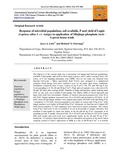| dc.description.abstract | The objective of the current study was to determine soil fungal and bacterial populations,
available P and uptake, and yield of white lupin (Lupinus albus) under varying P rates. The
source of P was minjingu phosphate rock (MPR). Soil for the study was obtained from
Egerton University Njoro agricultural field Twelve pots arranged in a randomized
complete block design with three replicates were set up under glass house conditions.
Treatments comprised three P rates; control (0 mg P pot-1), 60, 120 and 180 mg P pot-
1(corresponding to 0, 30, 60 and 90 kg P ha-1). Plant and soil samples were collected at 28,
56 and 103 days after sowing (DAS). Number of fungi and bacteria colony forming units
(CFU g-1 dry soil), soil available P and uptake, Dry Matter (DM) of shoots and pods and
lupin seed yield were determined. Number of bacteria increased progressively from 28 to
103 DAS. Fungal numbers increased from 28 to 56 DAS and declined at 103 DAS. At 28
DAS, bacterial and fungal numbers were significantly higher (P<0.05) in 60 and 90 kg P ha-
1 treatments. At 56 DAS, bacteria population was higher in control and 30 kg P ha-1 while
fungal numbers were higher in 90 and 60 kg P ha-1 treatments. At final harvest of lupin (103
DAS) lowest numbers of both organisms were observed in control treatments. The control
(0 kg P ha-1) had lower levels of available P in soil at all periods of sample collection. Soil
available P and uptake by lupin was higher in the 60 and 90 kg P ha-1 treatments at all
sampling periods. P uptake increased from 28 to 56 DAS and declined at 103 DAS. Lupin
DM, pod weight and seed yield were significantly higher in the 60 and 90 kg P ha-1
treatments. To optimize lupin production and its subsequent integration in the maize based
cropping systems of Njoro, application of MPR at a rate of 60-90 kg P ha-1 is a feasible | en_US |


